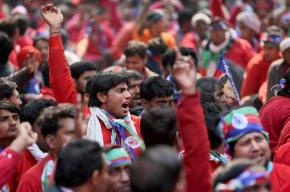Organized anger across India
Workers struck and protested across India on February 20 and 21 as part of a two-day national strike called by unions against the government's anti-labor policies. , secretary of the All India Progressive Women's Association, challenged the media distortions about the strike, in an article written for the Economic and Political Weekly.
THE DOMINANT media narrative about the two-day all-India strike called by trade unions was one of "hooliganism" by workers and inconvenience caused to the "public."
As usual, the main demands of the striking workers found little space in the media's discussion of the strike. The working class--usually invisible, both at the workplace and where they live--attained visibility on TV screens only as a "mob." Workers, whose labor is, after all, the source of all production, are seen and shown as a source of wanton and mindless destruction.
On February 20, the narrative of the workers as a destructive mob was constructed with images of stone-throwing, arson and looting in Noida on the first day of the strike. What followed has been an all-out crackdown on workers all across Noida.
Before we get to what is taking place in Noida, let us talk briefly about why India's working class responded so magnificently to the strike. The strike was successful in most of the vital sectors of India's economy: oil, telecommunications, mining, defense, power, ports and docks, insurance, transportation, postal, banking and taxation. Government employees also took part in the nationwide strike.

Industrial workers all over the country shut down production in both public and private industrial centers. In the National Capital Region (NCR), the Gurgaon-Dharuhera industrial belt of Haryana remained virtually closed on the second day of the strike. Contract workers and workers of the unorganized sector participated fully in the strike everywhere. Several states--including Kerala, Bihar and Jharkhand--observed a complete bandh (general strike).
Workers' Demands
What were the workers saying, by striking for two days?
They were demanding measures to curb price increases and unemployment. They were demanding that labor laws be enforced strictly. They were demanding compulsory registration of trade unions within 45 days, and immediate ratification of the ILO Conventions Nos. 87 and 98 that concern workers' right to organize and collective bargaining. They were protesting against the rampant contractualization of work of a perennial nature, in both public and private sector, in blatant violation of the law. They were demanding that mandated minimum wages be paid, and that the statutory minimum wage be fixed at not less than 10,000 Rupees.
The government and the industrialists who accuse workers of lawlessness are themselves guilty of systematically abusing the laws enacted to protect workers' rights.
In the Wazirpur Industrial Area of Delhi, around 20,000 workers came out on the streets on the second day of the strike in a protest march organized by various trade unions, including the All India Central Council of Trade Unions (AICCTU) and the Center of Indian Trade Unions (CITU).
For workers employed in the factories in this industrial area, one of the key issues is the blatant and open denial of minimum wages. Some years ago, a struggle to demand payment of minimum wages in one factory was met with a "united" opposition of all the industrialists in the area, and the local MLA as well. The struggle succeeded only thanks to the groundswell of support from workers across factories and their families, most of whom are migrants living in the local illegal slum cluster that abuts a railway track.
When a worker has been killed in a workplace accident and the management tries to fudge records to avoid paying his wages and compensation, women from this slum cluster, most of them married to factory workers, have spontaneously gheraoed (surrounded) the factory and forced the management to pay what is owed them. In the slum cluster where the workers live with the constant threat of eviction, basic amenities such as water, drainage and sanitation are not available. Most of the migrant workers struggle for voter identity cards and BPL ration cards.
Every time there is a major all-India strike, the response here is huge. During the strike, the anger of the young workers is palpable, and not uncommonly, factories that remain open and barricade their workers inside to prevent them from joining the strike are targeted. This is not wanton vandalism--it is a bid to free fellow workers from the factory that uses coercion to prevent workers from exercising their right to strike.
This time, too, the workers marched for hours in the lanes of Wazirpur, enforcing the strike, and they blockaded Delhi's Ring Road for a couple of hours. But there was no looting: what was seen was the collective, organized anger and energy of the working class.
Police Action Against the Workers
What, then, happened in Noida on February 20? For the most part, workers participated in the strike in Noida as they did in the rest of the country. But in a few pockets of Noida, especially Phase-II, there was arson and looting.
Who, in fact, was responsible for that violence? Clearly, it was not trade unions that planned and executed the arson--if they had, why would such actions be confined to a few pockets of Noida alone? Though the perpetrators of the violence are not known, the incident has been used by the Uttar Pradesh government, the police and the administration to strangle the workers' movement in Noida.
A virtual emergency has been imposed on Noida--at least on the working class. The Provincial Armed Constabulary is patrolling the area and conducting flag marches. Section 144 has been imposed all over Noida until the end of February. Reportedly, 150 people have been arrested against 338 FIRs. Trade union leaders have been systematically targeted and jailed. Many of them have been charged with attempted murder, arson, rioting and looting. Ordinary striking workers and even bystanders have been branded as criminals and jailed. The entire working class in Noida today has been criminalized.
Several of us from the Communist Party of India (Marxist-Leninist) (CPI(ML)) and All India Students' Association (AISA) visited Noida on February 22, following the arrest of 17 AICCTU activists on February 21.
On the morning of February 21, our activists--including Delhi-NCR AICCTU Secretary Shyamkishor Yadav--were sitting inside the AICCTU office in Noida Sector 10, which is on the road adjoining the Sector 10 slum cluster. The activists, most of them unorganized sector workers, including rickshaw pullers and street vendors, were preparing to hold a march in support of the second day of the strike. They were arrested inside their office, from which they could not have possibly violated Section 144! The AICCTU office in Sector 10 is very far (at least 20 kilometers away) from Noida Phase-II, where most of the violence occurred. The AICCTU activists had never even visited Phase-II.
On the morning of February 22, when we arrived at the Sector 10 office, there was a palpable feeling of terror among the local workers and activists. We were told it was not safe to stand near a trade union office. Eyewitnesses told us that on the previous morning, a large fleet of white ambassador cars (15 to 20 of them) with flashing red lights drew up and disgorged a posse of police, as well as several VIPs from the local police and administration. Media representatives were also reported to be in these cars--presumably "embedded" in the local administration. Once our activists were arrested inside their office, they were paraded in front of the media, while the top police officials informed the media that the "culprits" of the previous day's rioting had been caught!
We waited in our office, trying to gather people who could put up bail for those arrested. We were also calling up the police, trying to get information on the status and whereabouts of those arrested. Several police vehicles drew up, and a large number of cops descended on us, including the SHO of the Sector 20 police station. The latter told us that we must disperse immediately, or else she would have us arrested! They waited until we left the place. Clearly, being in the vicinity of a trade union office or being a trade union activist is enough to merit being arrested in Noida today.
We then went to the Phase-II police station where those arrested had been detained. At the police station, we were told that there was no question of bail, and that all those arrested would be jailed by evening. We asked to meet the arrested people and were told that one of us would be allowed to do so. I went inside the police station to meet our comrades in the lockup. I was told to switch off my mobile phone before going in. I realized later that the demand was made to prevent me from taking photographs of the conditions in which the arrested workers were kept.
The police lockup is a tiny 8-foot-by-8-foot room, totally dark, with no light whatsoever. Through the bars, I saw and greeted Comrade Shyamkishor. He is recovering from an accident, because of which he cannot sit on the floor easily, nor stand for long periods of time. But inside that tiny room, there were 45 men sitting and standing in impossibly cramped conditions. There was a toilet, I was told, but it was flooded and completely unusable. And the men had not been given water to drink for several hours.
They had been there since the night of February 21, cooped up in that pen and deprived of basic rights and dignities. Seeing me, several of the young workers, all migrants, were desperate to have me note down contact numbers of their family members, who would be worried about their whereabouts. They had not been informed about what they were being accused of, and what sections they were being booked under. Their families had not been informed about their arrest. Some family members who managed to reach the police station were not allowed to meet their arrested relatives.
When I asked someone about the conditions in which those arrested had been kept, he said, "What can we do? We have to keep them in a place allocated for such arrests by the government." I asked, "Had a politician or an industrialist been arrested, would they also be kept in such a lockup? Since a large number of people had been arrested, why could they not be detained in a stadium or any other large space? Why should they be denied the right to inform their families?" The answer was clear: the manner of the arrest and detention, and the denial of dignity, were punitive, intended to victimize and intimidate the entire working class.
I called the number given to me by one of the arrested boys, Ram Bahadur. His aunt kept saying he had been on his way to visit a relative when he vanished. "My boy is bright, educated and a hard worker--why is he being treated like a criminal?" she asked. Throughout the day, Ram Bahadur's family kept calling up, feeling utterly shocked and helpless about the arrest of their son and breadwinner.
Another concerned person trying to meet the detainees at the police station told us that among those arrested was a schoolmaster in Sector 10 Noida, who had been sitting on the road reading a paper when he was arrested. We secured a copy of one of the FIRs, which named 59 people, charging them with crimes as serious as attempted murder (Section 307). All those arrested have now been shifted to Dasna Jail.
In the FIR that named Shyamkishor Yadav, the SHO of Sector 20 police station stated that she and her team were on a raid when they received information that a group of people was gathering to protest. On reaching the spot, they found 34 people, whom they instantly recognized as the ones responsible for the arson and looting carried out the previous day. She further stated that they arrested all of them, and that their families would be duly informed of their arrest. She took care to add that the guidelines laid down by the honorable Supreme Court were followed to ensure that there were no human rights violations, and those arrested had no complaints against the police! The rest of the FIR was a litany of names of those arrested.
There is, as of now, no evidence of who exactly was responsible for the arson and looting in Noida Phase-II. But without any evidence, why are all trade union leaders and ordinary workers being randomly arrested and booked in blatantly concocted cases for serious crimes? Why is terror being unleashed against Noida's working class and trade union movement?
Working class anger and outrage in the NCR region, contrary to the media construction, is well-reasoned and has a strong basis. The main basis for this anger is the blatant strangulation of industrial democracy, denial of rights to organize and unionize, and the open violation of labor laws, including minimum wage and contract work laws. Noida's slum clusters where the workers live, are in stark contrast to the massive gated communities that are enclaves for the rich, carved out of what until recently was fertile farmland.
The industrialists, government and mainstream media rant righteously about the trade unions that "break the peace." Maintaining exploitative work conditions by denying the right to unionize and encouraging the open violations of labor laws, criminalizing Noida's entire working class and trade union leadership and jailing them on blatantly fake charges, and deploying paramilitary forces in the industrial areas are not acts of "peace." These are declarations of a virtual war on the working class.
The Uttar Pradesh government and the central government are both equally answerable for this war on the workers--happening so close to New Delhi, India's seat of power.
First published in Economic and Political Weekly.


